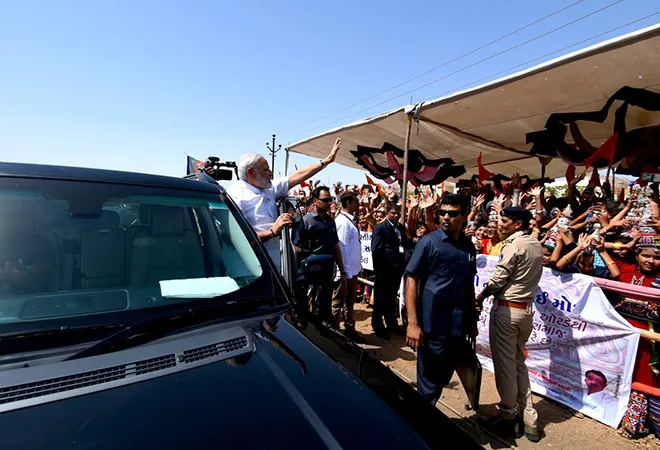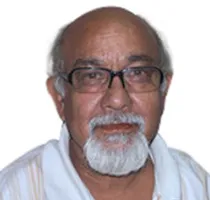-
CENTRES
Progammes & Centres
Location

Image Source: Narendra Modi/Twitter
PM Modi on his way to Kandla port
The Bharatiya Janata Party-led National Democratic Alliance (NDA) government is celebrating its third year in office in a unique way. From May 26, the day Prime Minister Narendra Modi was sworn in, to June 15, it is organising meetings at over 900 places across the country with leading theme of “Making of Developed India (MODI).
After being in power at the Centre for three years, PM Modi’s political fortune is smiling more broadly on him and he continues to enjoy people’s confidence. He has an unassailable lead over his political rivals both in the opposition ranks as well as within his own party.
Media surveys are unanimously pronouncing that Modi’s popularity is high and he continues to remain the main USP of the BJP for times to come. Whether surveys’ assessment really conform to the existing ground realities and hard data is, however, debatable -- because of the narrative of the three years of the NDA rule.
Modi has undoubtedly won the perceptional battle though the country at large still continues to battle basic problems or central issues of unemployment, poverty, bad governance, corruption and agriculture crisis, leading to farmers’ suicide.
With Modi being the vote getter and BJP president Amit Shah being the master electoral craftsman, the party is surely travelling on the road of electoral victories. It is expected to continue in the assembly elections later this year and the next year too, leading to the general election in 2019.
Modi’s appeal among the masses had begun to erode in the first half of the third year of the NDA government but it began to look up again in the second half resulting in the BJP’s convincing victories in the assembly elections in Uttar Pradesh and Uttarakhand. However, Modi’s appeal did not produce similar results in Goa and Manipur where the Congress emerged as the single largest party.
Modi’s charisma could not work in Punjab too, where the Shiromani Akali Dal (SAD)-BJP alliance lost power in the assembly election. However, it was more because of the failure and resentment against the SAD and the BJP had to pay a price for being the junior partner in the 10 years of the alliance government.
In the third year, the Modi government made big moves of demonetisation, surgical strike against Pakistan, enactment of the Central Goods and Services Act (GST) and its implementation from July this year and several other legislative and administrative steps.
In a stunning move on November 8, 2016, the Prime Minister caught citizens unware when he announced in his address to the nation that high value currency notes of Rs 1000 and Rs 500 denominations were no more valid. He said told the nation that the step was taken to bring out the black money, eliminate terror funding and weed out counterfeit currency from circulation.
Though none of the stated objectives were even partially achieved, the move proved to be a masterstroke for Modi’s personal image and credibility. His popularity soared among the poor and marginalised sections of society as the majority of them saw the demonetization move being against the well-off and rich.
Earlier, ostensibly to teach a lesson to Pakistan, country’s western neighbour who continue to aid and abet terrorism against India, a surgical strike across the Line of Control (LoC) was conducted on September 29 by the Indian Army.
The government also managed to get the GST Act, long pending from the Congress-led UPA (United Progressive Alliance) government time, passed through the two houses of Parliament. In fact, the Bill was stuck in Parliament, because of opposition from the BJP and other opposition parties. The BJP ruled State governments at that time, including that of Gujarat led by Modi as the chief minister, had opposed it. However, after coming to power, Modi brought in radical transformation in the party’s stand on the central tax.
On the economic front, notwithstanding the official claims, the national economic growth, despite tweaking in the calculation of the GDP, has hovered around 7 percent and in 2016-17 it is expected to remain at 7.7 percent. During the UPA’s period, the growth figure was 5.7 percent. Demonetisation brought down the GDP, according to some experts, at least by 1.5%, putting serious restrictions on growth.
Lower prices of crude oil in international markets provided a big relief to the Modi government, reducing the country’s import bill hugely.
Modi, campaigning for the BJP in the 2014 Lok Sabha elections and subsequently in State assembly elections, had promised to create two crore jobs every year, but the promised target is nowhere close to the figure. Unemployment or joblessness has been growing. In 2016-17, jobs increased by just 1.1%. If one was to take under employment or concealed unemployment in count, then the situation is alarming.
There is still not much visible change in the economy. No sector has really taken off. Much hyped initiatives like ‘Make in India’ or ‘Swachh Bharat Abhiyan’ or ‘Pradhan Mantri Jandhan Yojna” have not delivered desired results.
Agricultural sector continues to remain under stress with the rate of farmers committing suicides remaining high. A big push on irrigation that could have provided relief to the crucial sector has not taken off.
Similarly, the government has not freed Public Sector Banks and Public Sector enterprises from the government control.
Funding of elections or political donations, one of the root causes of corruption, has not even come under discussion. So, bringing in transparency in the process of political funding remains far away.
On the foreign policy front, one of the declared objectives of the government is to isolate Pakistan internationally, but the goal remains elusive. Relations with country’s neighbours with the exception of Bangladesh are under stress. Ties with Nepal and Sri Lanka are also not growing at desired pace.
India-China relations have been witnessing a downward trend. India’s decision to boycott One Belt One Road (OBOR) conference in Beijing on May 14-15 is the latest low point in the bilateral ties.
On the other hand, issues like cow protection resulting in acts of vigilantism by organisations ideologically close to the ruling party, rising nationalism bordering jingoism, intolerance towards liberal view, continuing challenge from left wing extremism and worsening situation in border State of Jammu & Kashmir coupled with jobless growth are some of the challenges rather crisis points in national politics and society.
The government’s media strategy and media management coupled with its social media activism has effectively succeeded in keeping the negative mood of the people under control. This has also helped the ruling party to put its political opponents down. If media management is enough to overcome challenges on ground without addressing them is difficult to say.
Whether Modi’s popularity with the people will sustain the winning streak until the next general election in 2019 is a question whose answer is not easy to discern at present, but present indicators strongly suggest that Modi alone can make the party win.
The views expressed above belong to the author(s). ORF research and analyses now available on Telegram! Click here to access our curated content — blogs, longforms and interviews.

Satish Misra was Senior Fellow at ORF. He has been a journalist for many years. He has a PhD in International Affairs from Humboldt University ...
Read More +